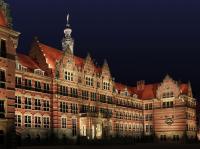Innovation in illumination projects
As a result of the research activity of WUT’s Lighting Division (Faculty of Electrical Engineering), gathered around prof. dr hab. Wojciech Żagan, a innovative new method is being used in the design of illumination projects for various constructions and buildings.
It is based on computer rendering which gives a very photo-realistic effect. It is a turning point in the approach towards 'object illumination' because it enables credible assessment of the final results of the project long before the realization of the illumination concept.
Computer simulation and analyses of buildings requires the creation of a 3D model of the illuminated building, giving reflective-transmission properties to particular separate parts of the façade and introducing photometric characteristics of the virtual space.
Next, the algorythms for measuring the effects of electromagnetic radiation which generate 3D graphics of the illuminated object. Those images are so realistic because luminance and colours generated on the monitor (or in print) without having to use scale correspond with the actual values of these parameters on the illuminated object. This innovative design method would not be possible without the research and simulations conducted at the WUT’s Lighting Division.
The achievements of WUT’s Lighting Division have become well known here in Poland, as well as outside our country. The level of professionalism reached by the team is so high that we can start talking of a school of illumination design at the Warsaw University of Technology. There have been over 100 projects made in the Division and most of them have come into being, among them the Presidential Palace, Sejm building – the Polish Parliament, Collegium Novum of the Jagiellonian University in Krakow, the Main Building of the Warsaw University of Technology, Warsaw Philharmonic, Saviour’s Church, Visitationist Church, Seminar Church in Warsaw and many more.







